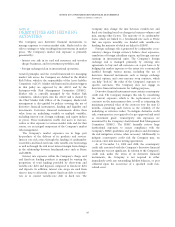American Express 2009 Annual Report Download - page 92
Download and view the complete annual report
Please find page 92 of the 2009 American Express annual report below. You can navigate through the pages in the report by either clicking on the pages listed below, or by using the keyword search tool below to find specific information within the annual report.
NOTES TO CONSOLIDATED FINANCIAL STATEMENTS
AMERICAN EXPRESS COMPANY
considered a variable interest entity and is consolidated by
American Express Receivables Financing Corporation V, LLC,
its primary beneficiary, which is in turn consolidated by the
Company.
The cardmember receivables securitized through this
entity are not accounted for as sold and continue to be
reported as owned assets on the Company’s Consolidated
Balance Sheets. The related securities issued to third-party
investors are reported as long-term debt on the Company’s
Consolidated Balance Sheets.
The following table summarizes the total assets and
liabilities held by the Charge Trust as of December 31:
(Billions) 2009 2008
Assets $8.3 $7.8
Liabilities $5.0 $5.0
These receivables are available only for payment of the debt or
other obligations issued or arising in the securitization
transactions. For these assets, the carrying values approximate
fair value because these are short-term in duration. The long-
term debt is payable only out of collections on the underlying
securitized assets. The fair value of these liabilities was $5.0
billion and $4.4 billion as of December 31, 2009 and 2008,
respectively.
LENDING TRUST AND CHARGE TRUST TRIGGERS
Under the respective terms of the Lending Trust and the
Charge Trust agreements, the occurrence of certain events
could result in payment of trust expenses, establishment of
reserve funds, or in a worst-case scenario, early amortization
of investor certificates.
The following table below presents key metrics reported by
each trust as of December 31, 2009:
Lending
Trust
Charge
Trust
Excess spread rate, net: (a) (b)
3-month average — Trigger event
Trust trigger for reserve account funding < 5.00% < 4.00%
Trust trigger for early amortization ≤0% ≤0%
3-month average — Actual rate
Floating rate series 14.75% 30.77%
Fixed rate series 10.36% 27.51%
Reserve account funding (millions):
Required amount(c)
Floating rate series $0 $0
Fixed rate series $0 $0
Seller’s interest percentage:
Required rate ≥7% ≥15%
Actual rate 25% 36%
Paydown rate — 3-month average:
Required rate N/A ≥60%
Actual rate N/A 94.4%
(a) The excess spread rate, net including issuer rate collections in the
Lending Trust is the sum of the net cash flows of the (i) excess
spread, net and (ii) issuer rate, as a percentage of the outstanding
investors’ certificates. Excess spread, net is the net cash flows from
interest and fee collections allocated to the investors’ interests
after deducting the interest paid on investors’ certificates, credit
losses, contractual servicing fees and other expenses. The
deductions may be a greater amount than the collections,
resulting in negative spread losses. Excess spread, net is reported
by the Company in securitization income, net in the Consolidated
Statements of Income. See above for the disclosure of excess
spread, net.
(b) The excess spread rate, net in the Charge Trust is the net cash
flows from the discounted portion of principal collections
allocated to the investors’ interests after deducting the interest
paid on investors’ notes, credit losses, contractual servicing fees
and other expenses, as a percentage of the outstanding investors’
notes.
(c) If the three-month average excess spread rate, net including issuer
rate collections falls below the trigger level of 5 percent or 4
percent for the Lending Trust and Charge Trust, respectively, the
affected Trust is required to fund a cash account in increasing
amounts ($3 million to $1.7 billion for the Lending Trust and $11
million to $170 million for the Charge Trust) depending on the
severity by which the excess spread rate, net falls below the trigger
level.
In the event of an early amortization of the Lending Trust, the
investor certificates would be required to be repaid over an
approximate four month period, based on the estimated
average life of the securitized loans. Although the repayment
of the investor certificates is non-recourse to the Company,
the Company would need an alternate source of funding for
the lending receivables assets.
In the event of an early amortization of the Charge Trust,
the underlying investor notes issued by the Charge Trust are
required to be repaid over an approximate one month period,
based on the estimated average life of the securitized
receivable.
90
























